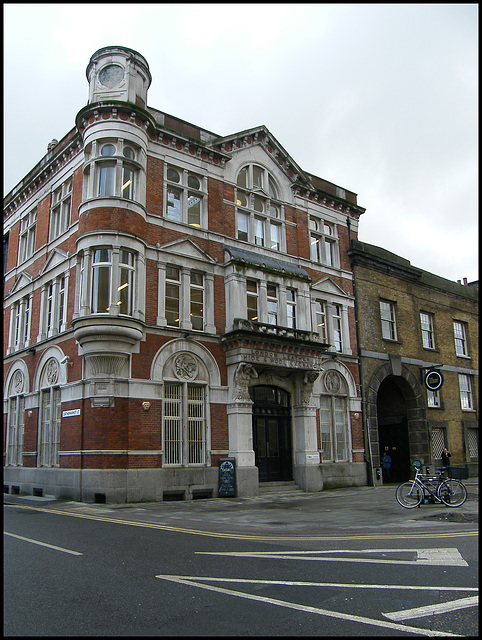Ship and Mermaid Row
Ship and Mermaid Row sign
Snowsfields street sign
corner of Snowsfields
Rose pub sign
The Rose at Snowsfields
The Rose at 123 Snowsfields
Guinness Trust courtyard
Guinness Trust railings
Guinness Trust Buildings
last of the old Manna Mission
sunlight on Snowsfields
Arthur's Mission sign
Arthur's Mission
Manna Centre
Shard in the backyard
shard at the back
Snowsfields
end of Snowsfields
Hardwidge Street sign
Vinegar Yard warehouse
light on the shard
light at the end of the tunnel
Leathermarket Street sign
Leather Exchange pub
Leather Exchange pub sign
Thames Water meter cover
Weston Street post box
hanging off the Shard
Hankey Place street sign
old woman on the pavement
Georgian houses in Long Lane
Georgian house in Long Lane
142 Long Lane
Aylesford House flats
Long Lane double pillar box
Long Lane shops
The Old School Yard
Shard by the old schoolyard
Wild's Rents corner shop
Wild's Rents street sign
Wild's Rents corner
The Ship pub sign
tacky new doors on old terrace
The Ship at Bermondsey
See also...
Keywords
Authorizations, license
-
Visible by: Everyone -
All rights reserved
-
172 visits
- Keyboard shortcuts:
Jump to top
RSS feed- Latest comments - Subscribe to the comment feeds of this photo
- ipernity © 2007-2024
- Help & Contact
|
Club news
|
About ipernity
|
History |
ipernity Club & Prices |
Guide of good conduct
Donate | Group guidelines | Privacy policy | Terms of use | Statutes | In memoria -
Facebook
Twitter



www.lyons-family.co.uk/Lyons/bermondsey-history/Bermondsey-photos/bermondsey-leather.htm
The Leather Market and Leather Exchange
The impressive building dates from 1879, although it is built on the site of its 1830s predecessor. Look at the roundels showing various activities in the leather industry. The complex was essentially divided into two, the market and the exchange. Some of the market, including slaughterhouses and animal pens, was destroyed in WWII. There was also a grand clock tower which has been destroyed or demolished. On the walls are roundels describing activities in the leather trade,
1.buying and selling of hides
2.unhairing and de-fleshing
3.hide being agitated in a pit.
4.tanned hide being rolled by hand and hides being hung up to dry.
"Bermondsey has been for many years the principal seat of the leather manufacture in England, and derives from this circumstance a character and appearance different from those presented by any other district in London. The cause to which this localisation seems to be most correctly assigned is the existence of a series of tide-streams, which twice in every twenty-four hours supply a large quantity of water from the Thames for the use of the tanners and leather-dressers.
The skins from nearly all the sheep slaughtered in London are conveyed to a Skin Market in the western part of Bermondsey, and there sold by factors or salesmen, who act for the butchers, to the fellmongers." (A Day in the Factories, 1843)
The writer says that although each type of leather worker was employed in very different tasks, the yards and buildings in which they worked looked very much the same; they would have lived 'over the shop' or very nearby. "The surface of the court or yard is in most cases intersected by pits, or square cisterns, in which the skins are steeped during some part of the manufacturing process." Henry Mayhew wrote of "a series of closely-adjacent pits, filled to the brink with a dark chocolate-coloured, thick liquid".
Leather prepared with Sumach (extract from a tannin-rich plant grown in Hungary) Goat, a thinner hide. This became Morocco leather, which took rich dyes well and was quicker to produce. It was used for coach linings and chair covers. An inferior type, made from split sheepskin - skiver - was used for book covers, hat linings, and pocket books.
Leather prepared with Alum - kid, imitation kid (made of sheepskin) and lamb. This process was called tawing, and the finished product was used for gloves and ladies' shoes. Kid was used for better products, and imitation kid for cheaper goods.
Curriers softened the hides, parchment makers created fine filmy sheets out of split sheepskins.
Leather prepared by tanning using solution of oak bark - oxen, bulls, buffaloes, cows - the strongest hides. These leathers took the longest to soak (up to two years) and were used for the soles of shoes and for saddles.
All leatherwork created foul smells. Alum was made partly of urine, and another essential ingredient for Alum preparation was 'pure' or dog faeces! Pure gatherers would be paid to pick it up from the streets and from pedigree kennels on the outskirts of London. (A 19th century public health inspection revealed that a railway arch was used to store the stuff in, giving the immediate area a very foul smell.)
Dickens remembers the Leather Market as full of evil smells from the hides and the substances they had been processed in.
Sign-in to write a comment.